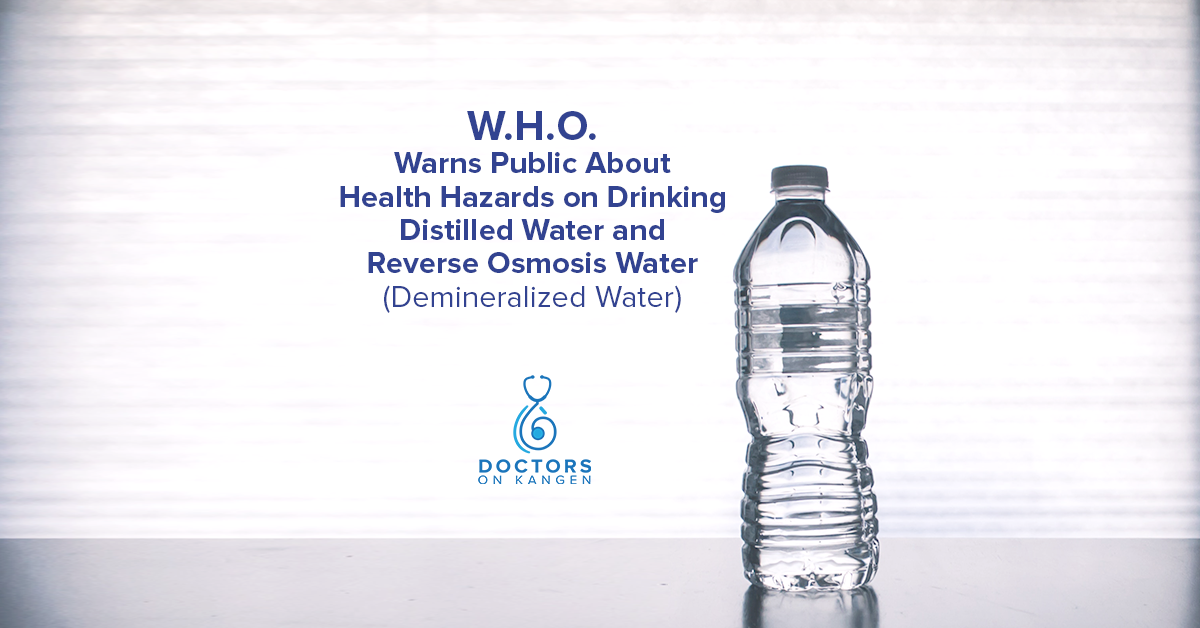
Having clean water is great, but it does not necessarily mean it's healthy for us.
Demineralized water is defined as water almost or completely free of dissolved minerals as a result of distillation, deionization, membrane filtration (reverse osmosis or nanofiltration), electrodialysis, or other technology.
The total dissolved solids (TDS) in such water can vary, but TDS could be as low as 1 mg/L.
Artificially produced demineralized waters: first distilled water and later also deionized or reverse osmosis-treated water, had been used mainly for industrial, technical, and laboratory purposes and not as drinking water until the 1960's when the limited drinking water sources became a problem.
Distilled Water
Distilled Water is the water that has undergone distillation; they produce it by boiling water and then condensing the collected steam back into a liquid.
Distilled water is more suitable for steam irons, car batteries, or medical equipment that needs water. But for humans? Drinking distilled water can even be detrimental to our health.
Reverse Osmosis Water
It is a water purification process that uses a partially permeable membrane to separate ions, minerals, and larger particles that cannot pass through this membrane.
Distilled water and water that passed through a reverse osmosis membrane are examples of demineralized water. In purifying the water and removing the impurities, it has also removed all the minerals (calcium, magnesium) from the water.
According to WHO, they come up with the report called "Health Risks from Drinking Demineralised Water,” they stated here, the possible adverse consequences of low mineral content water consumption were discussed in the following categories:
1. Direct effects on the intestinal mucous membrane, metabolism and mineral homeostasis, or other body functions.
WHO and the German Society of Nutrition found similar findings of distilled water and warned the public from using it.
- Demineralized water has a negative effect on homeostasis mechanisms (the body's self-regulating processes), compromising the mineral and water metabolism in the body.
The Society, in its position paper, explains that water in the human body always contains electrolytes (e.g., potassium and sodium) at specific concentrations controlled by the body.
Since the body never eliminates fluid in the form of "pure" water but always with salts (Sodium, Potassium, other minerals). If distilled water is ingested, the intestine has to add electrolytes, taking minerals from the body's reserves.
WHO Findings are: Drinking of distilled or RO water leads to the following:
- The dilution of the electrolytes dissolved in the body.
- Inadequate body water redistribution between compartments may compromise the function of vital organs.
- Symptoms at the beginning of this condition include tiredness, weakness, and headache; more severe symptoms are muscular cramps and impaired heart rate.
- A more severe course of such a condition coupled with brain swelling, convulsions, and metabolic acidosis was reported in infants whose drinks had been prepared with distilled or low-mineral bottled water.
2. Little or no intake of calcium and magnesium from low-mineral water.
Calcium and magnesium are both essential elements.
Calcium is a substantial component of bones and teeth. In addition, it plays a role in our nervous system, heart and contraction of muscles, the transmission of information across cells, and even clotting of blood.
Magnesium plays an essential role as a cofactor and activator of more than 300 enzymatic reactions in our body. Regulating sugar storage in our body, energy production, transport of elements such as sodium, potassium, and calcium through membranes, synthesis of essential proteins in our body, and even functions of our neurons and muscle contraction.
Cases in the Czech and Slovak populations who began using reverse osmosis-based systems for final treatment of drinking water at their home taps in 2000-2002:
- Within several weeks or months, various complaints suggestive of acute magnesium (and possibly calcium) deficiency.
- The complaints included cardiovascular disorders, tiredness, weakness, or muscular cramps and were essentially the same symptoms listed in the German Society for Nutrition warnings.
3. Low intake of other essential elements and microelements.
Recent epidemiological studies among Russian populations supplied with low-mineral drinking water may be a risk factor for hypertension and coronary heart disease, gastric and duodenal ulcers, chronic gastritis, goiter, pregnancy complications, and several complications in newborns and infants, including jaundice, anemia, fractures and growth disorders.
4. Loss of calcium, magnesium, and other essential elements in prepared food.
Since most nutrients are ingested with food, the use of low-mineral water for cooking and processing food may cause a marked deficiency in the total intake of some essential elements that were much higher than expected with the use of such water for drinking only.
The current diet of many persons usually does not provide all necessary elements in sufficient quantities. Therefore, any factor that results in the loss of essential elements and nutrients during food processing and preparation could be detrimental for them.
5. Possible increased dietary intake of toxic metals.
Another problem with lower mineral water is their storage. Distilled water or RO water can pull minerals from any material it touches. This means it can absorb microplastics if stored in plastic bottles, toxic metals from pipes, storage tanks, or whatever substance is in the container holding it.
Increased risk from toxic metals may result in two ways:
1.) higher leaching of metals from materials in contact with water resulting in increased metal content in drinking water, and
2.) lower protective (antitoxic) capacity of water low in calcium and magnesium.
Low-mineralized water is unstable and, therefore, highly aggressive to materials with which it comes into contact. Such water more readily dissolves metals and some organic substances from pipes, coatings, storage tanks and containers, hose lines, and fittings. It is incapable of forming low-absorbable complexes with some toxic substances and thus reducing their harmful effects.
To a lesser extent, calcium and magnesium in water and food are known to have antitoxic activity. These can help prevent the absorption of some toxic elements such as lead and cadmium from the intestine into the blood.
Although this protective effect is limited, it should not be dismissed.
6. Possible bacterial contamination of low-mineral water
All water is prone to bacterial contamination in the absence of a disinfectant or due to microbial re-growth in the pipe system after treatment.
Although an intact desalination membrane should remove all bacteria, it may not be 100 % effective (perhaps due to leaks), as documented by an outbreak of typhoid fever caused by reverse osmosis-treated water in Saudi Arabia 1992.
In conclusion of this WHO report states that:
- Drinking water should contain minimum levels of certain essential minerals (and other components such as carbonates).
- Demineralized or low-mineral content water – in the light of the absence or substantial lack of essential minerals – is not considered ideal drinking water. Therefore, its regular consumption may not be providing adequate levels of some beneficial nutrients.
- Sufficient evidence is now available to confirm the health consequences of drinking water deficient in calcium or magnesium.
- Intake of water low in magnesium may be associated with a higher risk of neuronal motor disease, pregnancy disorders (so-called preeclampsia), sudden death in infants, and some types of cancer.
- Recent studies suggest that the intake of soft water, i.e., water low in calcium, is associated with a higher risk of fracture in children, certain neurodegenerative diseases, pre-term birth and low weight at birth, and some types of cancer.
- International and national authorities responsible for drinking water quality should consider guidelines for desalination water treatment, specifying the minimum content of the relevant elements such as calcium, magnesium, and TDS.
Change your Water
Change Your Life
Pinky De Leon - Intal, MD
Sources:
HEALTH RISKS FROM DRINKING DEMINERALISED WATER
https://www.who.int/water_sanitation_health/dwq/nutrientschap12.pdf
READ MORE:
- How To Look 10 Years Younger in 2 Days
- Why you don’t feel bloated when drinking Kangen Water?
- The Science Behind the Alkalinity of Kangen Water and How it Differs from Other Alkaline Water
- The science behind this Kangen water, and why it works so well?
- 7 Facts about the Antioxidant Property of Kangen Water
- Is Kangen Water a Miracle Water or Just Another Hype?
- Kangen Water Machine is More Than Just a Filter; It’s a Medical Device



Leave a Reply